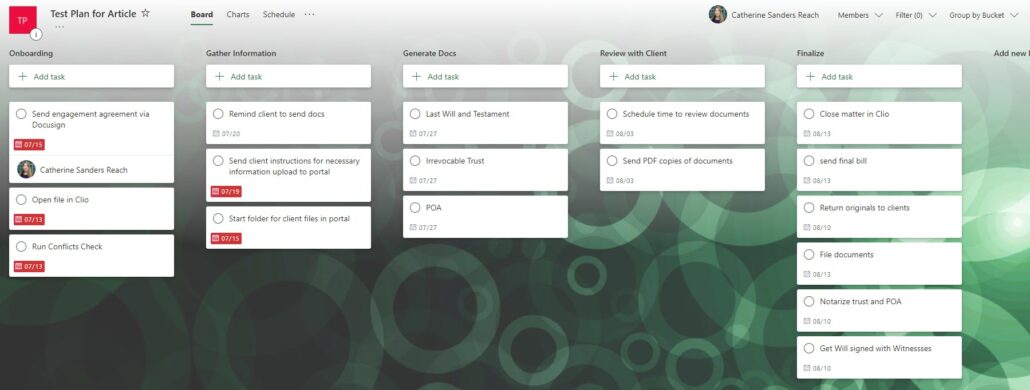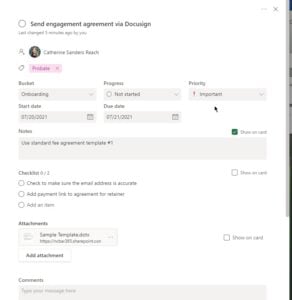MS Planner: Simple Project Management Tool
If you have explored tools to create task lists, with assignments and deadlines, you know that there are a whole lot of options on the market. If you are curious if a project management tool would help your firm stay on top of multiple matters from a task-based perspective, as well as monitor your team’s progress without micro-management, consider starting with an app you already have if you are a Microsoft 365 business plan subscriber – Planner. Microsoft Planner is more robust for managing a group than MS To-Do and can be incorporated into Teams and SharePoint.
About Planner
Microsoft Planner comes with Business and Enterprise versions of Microsoft 365. It is not available as a stand-alone product, unlike similar Microsoft apps To Do and Project. While To Do is part of the Microsoft 365 suite, Project is not. Microsoft Planner is not as robust as other project management applications like Monday, Zoho, Asana or Trello. However, it is robust enough, especially for firms that are just starting out using a project management tool.
Within Microsoft 365 Planner is available as a browser-based application, on the iPhone or on Android. There is no desktop version. You can access Planner by going to Office.com and logging in with your business plan credentials. Then on the far-left column mouse over the icons and find Planner, which looks like a green F. If you don’t see it click on the square of squares icon at the bottom of that column to view all the applications available with your Microsoft 365 subscription.
Create a Plan
There are several ways to create a Planner plan. You can incorporate Planner plans into SharePoint or MS Teams. Through Teams you can create a plan using “Tasks by Planner and To Do” by clicking on the plus sign in a Teams channel. A plan created through the stand-alone Planner can be linked to from a SharePoint site or you can create a new plan directly from within a SharePoint site.
When you create a new plan in Planner you will add members. These will be people from within your firm, company, or organization. The initial view in Planner is organized as a Kanban board, which is part of the Agile project management methodology. While you can certainly keep your columns (“swimlanes”) simple, like “to do” “doing” and “done” you can get creative. For instance, for an estate planning matter your project template could include columns like “client onboarding”, “gather information”, “generate documents”, “review with client”, “finalize” and “completed”.
Within each column you add tasks. The tasks (or “cards”) specify what needs to be done, by whom and by when. In Planner each task card can have a “checklist” (subtasks), labels and priorities for sorting and filtering, notes, comments, and attachments. As activity progresses on a task it can be marked as finished and moved to a different column.
By default, anyone who is assigned a task receives an email notification. In Planner a task can be assigned to multiple people, which is unique in project management tools. When a task is due in 7 days, today or late you will also receive email reminders for tasks assigned to you. If you want to leverage the group email address to notify everyone involved of progress at the top of the Planner page click the ellipses (…) and from the drop down menu choose “Plan settings”. In the column that opens on the right click “Notifications” at the top and check the box by the option “send email to the group when a task is assigned or completed”.
Planner Templates and Portability
There is no way to create a reusable template in MS Planner. You can, however, copy a plan and make edits to it. If it is a complex plan then that would require changing a whole lot of information. To get around this deficiency you could create a plan as a template and then copy it, rather than copying an actual plan. You could leave due dates and assignments blank in the tasks so that you were just copying the columns and tasks and when you begin a new matter the deadlines, assignments, and other details are filled in. Or you could design your columns by date, depending on the predictability of the matter and the workflow. Your columns could be “2 Months Out” “1 Month Out” “2 Weeks Out”, etc.
Under the ellipses in a plan you have options to add the plan to a Sharepoint site (Sites), create a link to the Plan, export the plan to Excel, add the plan to an Outlook calendar with an iCalendar feed or open a corresponding MS OneNote Notebook. By adding the plan to an Outlook calendar, you can send the link to your team and they can view deadlines and due dates in their Outlook calendar alongside their personal calendar.
Views
Planner plans have lots of filters. Each person looking at the plan can see what is assigned to her or others, tasks by due date, priority, or by keyword. You can also group by “bucket” to see the plan organized by column (the default) or view the plan by “assigned to” “progress” “due date”, etc.
At the top of a plan you can switch your view from Board to Charts or Schedule. Charts shows plan overall status in pie charts and bar charts by tasks progress, by plan member and by priority. Charts view also shows a list of tasks on the right side you can scroll through. Schedule view plots your plan on a calendar. Adding tasks to the Plan in a calendar view may be easier to do, so you can create the “bones” of you plan and then go to the Schedule view to drag and drop tasks onto the calendar. This might make it easier to assign deadlines from a template. You can also create your plan in Schedule view if you would rather your plan be focused purely on deadlines instead of the “swimlane” columns. You can simply have 2 buckets – to do and done.
Conclusion
Microsoft Planner is a great starter project management tool. It has plenty of features if you are interested in seeing if project management works for your firm. The hardest part of leveraging any project management application is not the tool itself but creating your strategy for how you want to structure your projects so that they are repeatable. This may take some trial and error, but ultimately with refinement can help you and your team stay on track with the hundreds or even thousands of tasks required to complete a legal matter.

